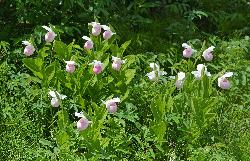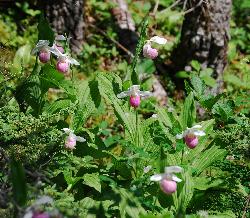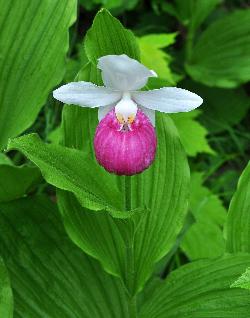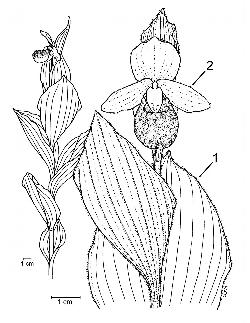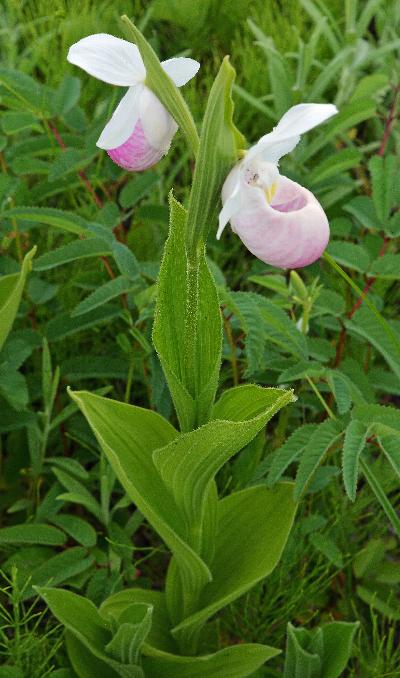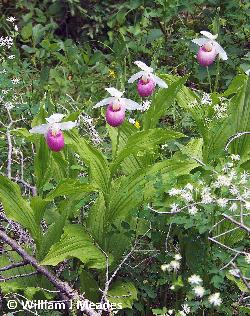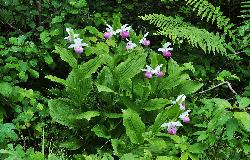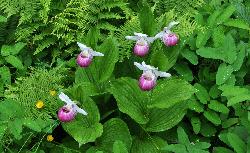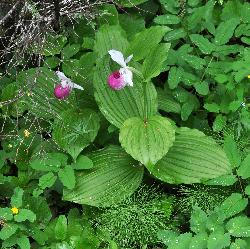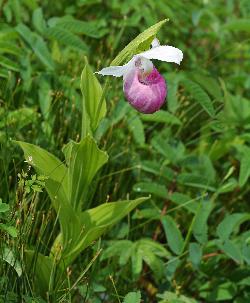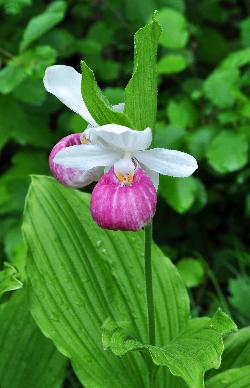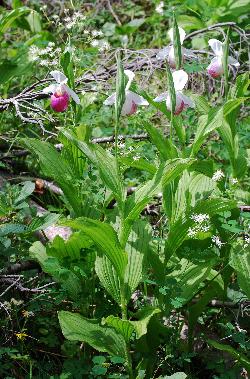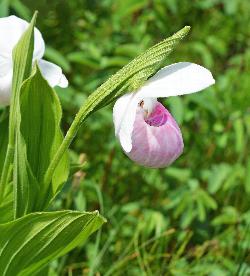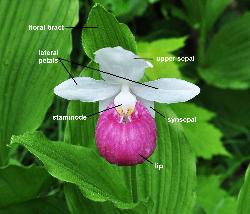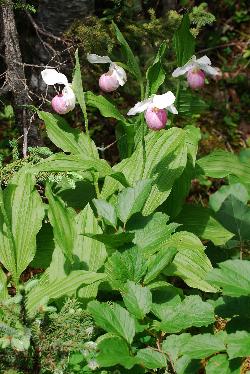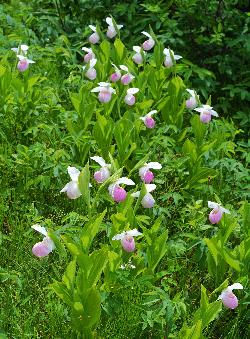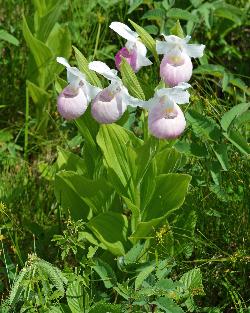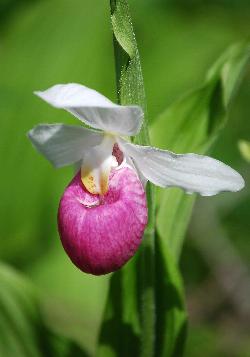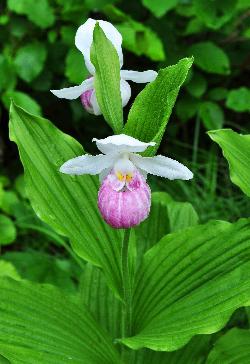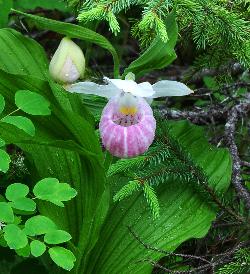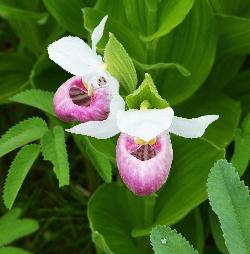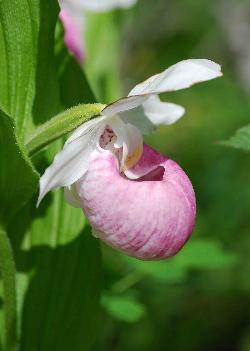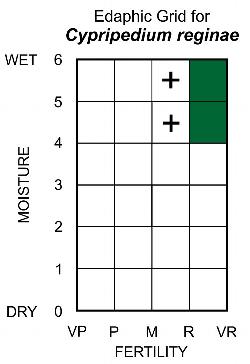Fr: cypripède royal, cypripède de la reine, sabot de Venus
Orchidaceae - Orchid Family
Note: Numbers provided in square brackets in the text refer to the image presented above; image numbers are displayed to the lower left of each image.
General: A long-lived, perennial forb of nutrient-rich treed fens, 2–9 dm tall, with cauline leaves and an erect stem that terminates in 1–2 showy pink and white flowers [1–4]. As with most orchids, showy ladyslippers depends on a mycorrhizal relationship with a soil fungus to grow successfully, thus orchids should not be transplanted, as they will not persist without the right soil type, pH, and mycorrhizal fungus. But in their natural habitat, pink ladyslipper plants can persist for 50+ years; initial flowering takes up to 16 years (Owen 2016). Warning: The leaves and stem of showy ladyslipper plants contain a toxic quinone, cypripedin, which can cause contact dermatitis (blistering rashes) in sensitive people, producing a poison ivy-type rash (Reddoch and Reddoch 1984, Munro 2015).
Key Features: (numbers 1–2 refer to the illustration [5])
- Leaves 3–9, simple, cauline, alternate, sessile, and densely glandular-pubescent. Blades are ascending, with broadly elliptic to ovate blades, 10–27 cm long, sheathing at the base, tapering to a pointed apex, and with 7–13+ prominent parallel veins.
- One to 2 large showy flowers terminate the flowering stem; each flower has a conspicuous pouch-like pale to deep pink lip (rarely all white) and oblong to broadly ovate white lateral petals and upper sepal. The two lateral sepals are fused together into an ovate synsepal that subtends the lip.
- The fruit is a dry ellipsoid capsule.
Stems: The erect densely glandular-pubescent (glandular-hirsute) stem [6] arises from a stout rhizome with fibrous roots. Crowded colonies often develop through vegetative propagation of the rhizome [7].
Leaves: The 3–9 simple, cauline leaves are sessile, alternate, and overlapping [8–9]. Leaf blades are ascending to spreading, broadly elliptic to ovate [10–11], 10–27 cm long by 5–16 cm wide, plicate, with 7–13+ prominent parallel veins and several smaller parallel veins between the larger ones. Leaf blades taper gradually to a sheathing base and an acute to obtuse apex, margins are entire, flat to somewhat undulate, and ciliate; both leaf surfaces are densely glandular-pubescent.
Flowers: Bisexual; flowers are terminal, solitary or in pairs (rarely more) [12–13], and fragrant. Each flower is subtended by an erect leaf-like floral bract [14–15], which is green, elliptic to lanceolate, acute, pubescent, and up to 13 cm long by 6 cm wide. The flowers have bilateral symmetry with white sepals and lateral petals, and a lip that is typically pale to deep pink. In all Cypripedium species, the 2 lateral sepals are fused together, forming a synsepal that subtends the large lip; in the showy ladyslipper, the synsepal is ovate and 2.4–4.2 cm long by 1.5–3.7 cm long [16–17]. The upper (dorsal) sepal is broadly elliptic to nearly orbicular, 2.5–4.5 cm long by 1.8–4.2 cm wide, and arches over the column [18–19]. The spreading lateral petals are lanceolate to oblong, blunt, and flat, 2.5–4.7 cm long by 0.6–1.7 cm wide. The base of the lip is white while the remainder of the lip is usually pale to deep pink in colour [20–23], but albino forms do occur). The lip is obovoid, 2.5–5.3 cm long, pouch-like, and firm. Pollinators gain access to the interior of the lip through a circular to oval orifice, 1.8–2.8 cm long, located at the top of the lip; the margins of the orifice are curved inward [24–26]. The column supports 2 globose white anthers, one on either side of the column [27], and terminates in a prominent ovate to shield-shaped white staminode, marked with yellow toward the tip and variously spotted with magenta [16, 23]. The interior of the lip has lines of magenta dots along the veins. The inferior ovary, enclosed by the floral bract, is cylindrical to ellipsoid and pubescent.
Pollination of showy ladyslipper is by insects (entomophily) and occurs in a manner similar to that described for the pink ladyslipper, but with different effective pollinators. One Vermont study documented syrphid flies (Syrphus torvus) as the primary pollinators, but flower beetles (Trichiotinus assimilis) also contribute to pollination (Vogt 1990). A recent Missouri study by Edens-Meier et al. (2013) demonstrated that although many different types of insects visited showy ladyslippers, effective pollination occurs only by insects whose measurement are compatible with the inner dimensions of the flower. Six species of medium-sized bees from 3 genera (Anthophora, Apis, and Megachile) were observed with pollinia attached exclusively to the upper thorax region, deposited in that position as they pressed against the anther while exiting through the rear orifice of the flower. Smaller bees exited flowers through the same rear orifice as pollinators, but their smaller size allowed them to exit without contacting the anthers. In contrast, larger bees entered and exited through the large upper orifice, as they were too large to leave through the orifice behind the anthers (Edens-Meier et al. 2013).
Fruit: An ellipsoid brown capsule, to 4 cm long by 1.5 cm wide, splitting vertically along the sides of the capsule to release thousands of minute seeds that are dispersed by wind (anemochory).
Ecology and Habitat: The showy ladyslipper is restricted to partially shaded forested fen habitats where there is lateral seepage in the mucky, slightly acid, to near neutral soils [28–29]. Populations spread mostly by shallow-rooted rhizomes. Although it produces large quantities of seed, germination is low and up to 8 years of growth is required before flowers are produced. The relative scarcity of this species is due, at least in part, to its narrow habitat requirement and the general scarcity of the rich forested fen habitats.
Edaphic Grid: See image [30]: the Edaphic Grid for Cypripedium reginae.
Forest Types: The showy ladyslipper is only found in the Carici-Piceetum (Carex-Black Spruce Fen Association) in western Newfoundland.
Succession: The showy ladyslipper is not usually directly impacted by logging because it occurs in forested fens, which do not produce merchantable timber. However, logging machines crossing fens between merchantable stands can cause soil compaction that is devastating to these orchid populations. Fire is also a rare event in these wet habitats, but it could be a problem in extremely dry years due to the shallow rooting habit of this species.
Distribution: The showy ladyslipper is native to north-temperate eastern North America and occurs from insular Newfoundland to Saskatchewan. Within Newfoundland and Labrador, it occurs only in calcareous tree fen habitats and does not extend north into the Great Northern Peninsula (Rouleau and Lamoureux 1992); it is absent from Labrador (Meades et al. 2018). In the United States, it occurs most commonly in States bordering the Great Lakes; disjunct populations occur in the eastern and east-central States, extending south from Maine to western North Carolina and northern Tennessee and Arkansas, and west along the northern border States to disjunct locations in eastern North Dakota (USDA, NRC 2016).
Similar Species: The showy ladyslipper is the largest Cypripedium species in Newfoundland; its size (to 9 dm), several cauline leaves, and bi-coloured white and pink-lipped flowers make it easy to identify. The pink ladyslipper (Cypripedium acaule Aiton) also has a pink lip, but has narrower, darker reddish-brown sepals and petals and only 2 leaves, which are basal. Non-flowering plants of the showy ladyslipper may be confused with those of the green false hellebore (Veratrum viride Aiton), but this latter plant is restricted in the province to western Labrador, while the showy lady slipper is found only in western Newfoundland.



